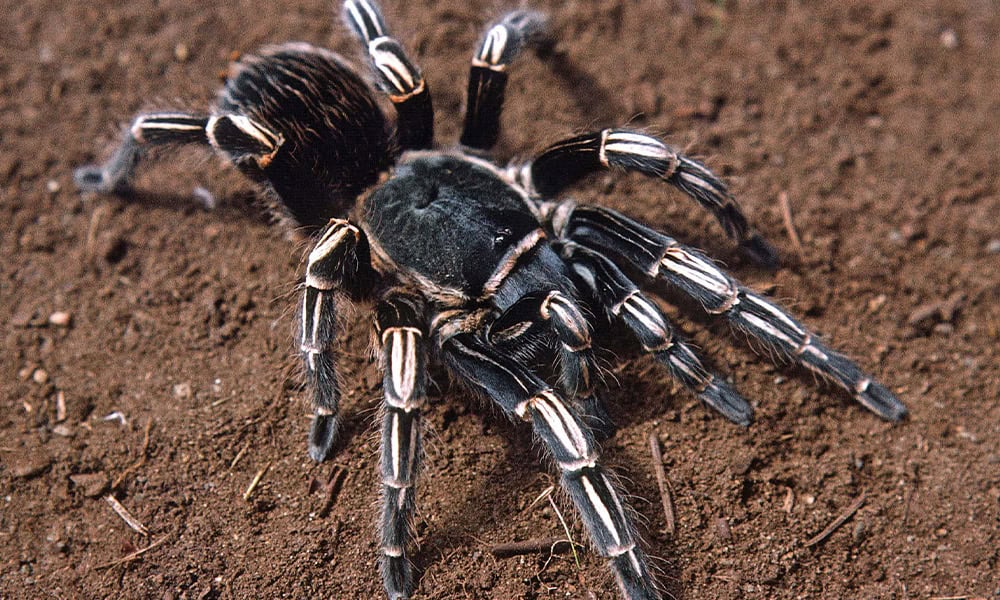I’m going to come out and say it immediately, I’m not particularly knowledgeable about Costa Rica’s spiders. This little country boasts over 2,000 species that come in a dizzying variety of sizes, shapes, and colors and you would need to talk to a knowledgeable arachnologist (arachnid scientist) to get any information about the vast majority of them. That being said, Costa Rica is a tiny country and since it hosts a couple thousand different kinds of spider, I have had experiences with a few. This overview starts out rather specific and then becomes decidedly less so.
Costa Rican Zebra Tarantula
There are about 50 different species of tarantula in Costa Rica. The one that I’ve run into the most frequently in Guanacaste is the Costa Rica zebra tarantula or stripe-kneed tarantula (Aphonopelma seemanni). In Spanish, they’re commonly known as the pica caballo (horse stinger) because people traditionally thought that they did something evil to horse’s feet at night causing lesions (which is not the case).
A couple of cool things about these spiders are they’re big, up to a five-inch span, and they’re long-lived, the males can live up to about 5 years, while the females can get all the way to twenty. They live in deep tunnels in the ground that can easily be identified because they’re perfectly circular, and if you peer inside, you can see webbing in the hole.
One of the most interesting interactions I’ve witnessed with this species is them being dragged to their doom by tarantula hawks, a species of giant wasp that uses tarantulas as food for its developing young. You know you’re in a wild place when you witness an enormous wasp dragging a humongous spider across the ground in front of you.
All The Spiders in my House
There are a wide variety of spiders that have lived in and around the various houses my family and I have lived in during our time in paradise. While I very infrequently recognize the species that we’re dealing with, they can be broken down into two categories, spiders that seem interesting and spiders that seem like a problem.
Spiders that seem interesting usually either live outside in the yard or are small enough that it seems inconsequential that they live in the house with us. The outside spiders often come in quite beautiful shapes and colors. I have no idea what the species names are but there seems to be a never-ending variety with different shaped, often spikey, abdomens. Recently, we had a particularly interesting one that set up camp on the pool deck that my wife would greet each morning when she poked around in her garden and the boys and I would throw a fly into its web every once in a while.
The spiders that seem like trouble are most frequently found in the house and happen to be a size that seems just too big to ignore. A few times our old friend the Costa Rica zebra tarantula got into the house somehow and that’s a show-stopper. Most of the time it’s some species of spider that resembles what we call a wolf spider in Pennsylvania.
They’re significantly smaller than tarantulas but they’re big enough and often moving way too fast. These guys like to make surprise appearances in the depths of laundry baskets and while quickly scampering towards your unguarded toes in the shower. The general move is to use a broom or broom/dustpan combo as relocation devices.
All the Spiders that Land on my Face
I kind of think about entering the forest like I think about going for a swim in the ocean. Swimming in the ocean is a good time, but if I really thought about the variety of creatures, I really wouldn’t want touching me while I’m in there, I might not leave the beach. While walking through the underbrush of a forest, especially on well-defined trails, I will inevitably encounter a wild variety of spiderwebs that will collapse upon me, leaving its inhabitant scampering across my face.
How many different species have smacked me in the nose? Who knows? If I thought about it too much, I’d probably freak myself out. Instead, I use their webs to usher them off my face and I keep moving without thinking about it too much.
About the Author
Vincent Losasso, founder of Guanacaste Wildlife Monitoring, is a biologist who works with camera traps throughout Costa Rica






